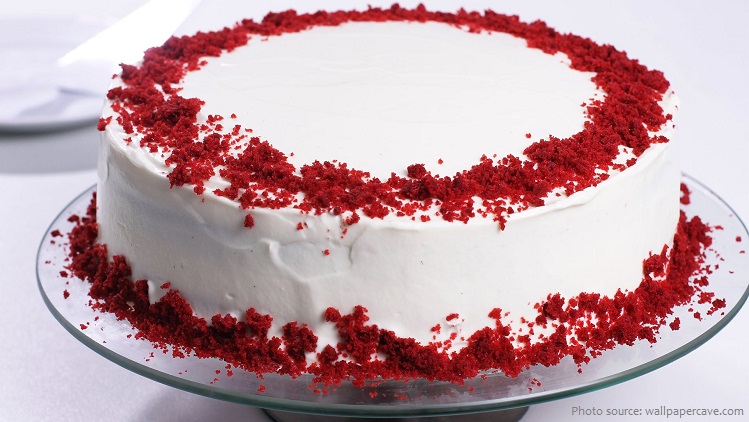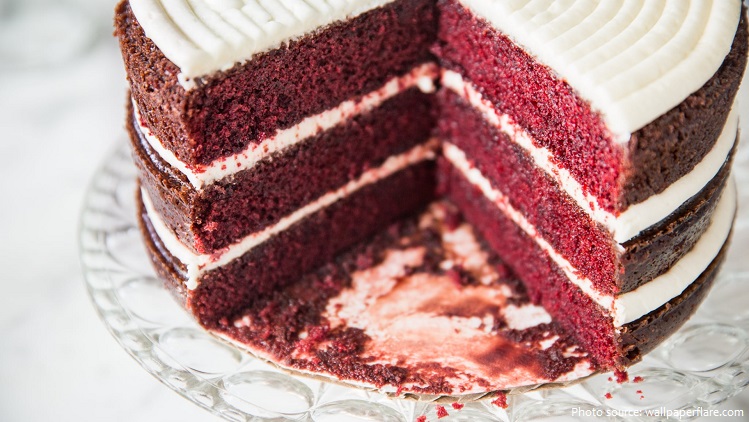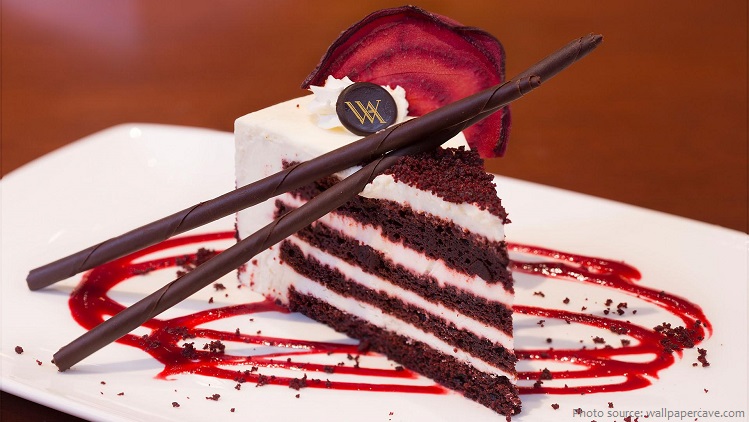
Red velvet cake is traditionally a red, red-brown, crimson, or scarlet-colored cake, layered with ermine icing.
Common ingredients include buttermilk, butter, cocoa, vinegar, and flour. Beetroot or red food coloring may be used for the color.
Red Velvet experienced an explosion of popularity in the last two decades. Besides the namesake cake, Red Velvet is now available in cupcake form along with pancakes, cookies, ice cream, and even lattes!
The cake has gained popularity in the 20th century, but its roots stretch further back.

“Velvet” was a term used in Victorian England to describe cakes with a fine crumb and a soft texture, distinct from other confections such as pound cakes and sponge cakes.
The first velvet cake was born in the 1800s, during a time when American cooks were perfecting their own cake recipes. Using almond flour, cocoa, or cornstarch to break down the protein in flour, a finer textured cake emerged – dubbed velvet cake.
It is believed that a sister to red velvet cake was born in this time and place, and was made in a similar style using deeply saturated chocolate to produce not only its signature dark color, but a name that stuck.
The result of using cocoa powder in a similar recipe produced what then became called “mahogany cake.”
As the cake recipe sifted through kitchens and cooks in the 1920s and 1930s, it picked up an iconic Southern ingredient, buttermilk, which further amplified the cake’s natural tanginess — and its acidity. Combined with the cocoa that was available at the time, the cake had a remarkably red shade.

In the 1930s, the first modern red velvet cake was served at the Waldorf Astoria, appearing later at Eaton’s department store in Toronto.
Adams Extract, a Texan company, is credited with bringing the red velvet cake to kitchens across America during the Great Depression era, by being one of the first to sell red food coloring and other flavor extracts with the use of point-of-sale posters and tear-off recipe cards.
Traditionally, red velvet cake is iced with a French-style butter roux icing (also called ermine icing), which is very light and fluffy, but time-consuming to prepare. Cream cheese frosting and buttercream frosting are variations that have increased in popularity.
But red velvet wasn’t always popular with the culinary crowds. Irma S. Rombauer wrote in the 1943 edition of The Joy of Cooking: ‘Generally popular, but not with me, which is not to be taken as a criterion.

When foods were rationed in the US during World War II, bakers used boiled beetroot juices to enhance the color of their cakes. Beetroot is found in some red velvet cake recipes. Beetroot was and is used in some recipes as a filler or to retain moisture.
In Canada, the cake was a well-known dessert in the restaurants and bakeries of the Eaton’s department store chain in the 1940s and 1950s. Promoted as an exclusive Eaton’s recipe, with employees who knew the recipe sworn to silence, many mistakenly believed the cake was the invention of the department store matriarch, Lady Eaton.
James Beard claimed the cake as ‘bland and uninteresting,’ and red velvet struggled for a spotlight in popular cookbooks in the 1980s and early 1990s. But after appearing in the 1989 film Steel Magnolias, red velvet cake became a star.

In 2000, Cake Man Raven in Brooklyn sold red velvet cakes to celebrities – in New York City, Magnolia Bakery’s red velvet cake was a top seller, eventually adding red velvet cupcakes to the menu.
By 2005, red velvet was a staple at nearly every upscale bakery across the nation.
In 2011, America’s love for red velvet reached its pinnacle, with red velvet fried chicken at American Cupcake in San Francisco – red velvet lattes at Dunkin’ Donuts – red velvet Pop-Tarts – and red velvet tea at the Republic of Tea.
Today, as home cooks and professional chefs alike are trying to veer away from artificial dyes and unnecessary ingredients, many are turning back to that WWII hacks, beets, for natural red hues. At Atlanta’s Miller Union, you can order an exceptionally red and elegant red velvet cupcake that’s dyed entirely by beets.